The effect of time spent in rehabilitation on activity limitation and impairment after stroke
- PMID: 34695300
- PMCID: PMC8545241
- DOI: 10.1002/14651858.CD012612.pub2
The effect of time spent in rehabilitation on activity limitation and impairment after stroke
Abstract
Background: Stroke affects millions of people every year and is a leading cause of disability, resulting in significant financial cost and reduction in quality of life. Rehabilitation after stroke aims to reduce disability by facilitating recovery of impairment, activity, or participation. One aspect of stroke rehabilitation that may affect outcomes is the amount of time spent in rehabilitation, including minutes provided, frequency (i.e. days per week of rehabilitation), and duration (i.e. time period over which rehabilitation is provided). Effect of time spent in rehabilitation after stroke has been explored extensively in the literature, but findings are inconsistent. Previous systematic reviews with meta-analyses have included studies that differ not only in the amount provided, but also type of rehabilitation.
Objectives: To assess the effect of 1. more time spent in the same type of rehabilitation on activity measures in people with stroke; 2. difference in total rehabilitation time (in minutes) on recovery of activity in people with stroke; and 3. rehabilitation schedule on activity in terms of: a. average time (minutes) per week undergoing rehabilitation, b. frequency (number of sessions per week) of rehabilitation, and c. total duration of rehabilitation.
Search methods: We searched the Cochrane Stroke Group trials register, CENTRAL, MEDLINE, Embase, eight other databases, and five trials registers to June 2021. We searched reference lists of identified studies, contacted key authors, and undertook reference searching using Web of Science Cited Reference Search.
Selection criteria: We included randomised controlled trials (RCTs) of adults with stroke that compared different amounts of time spent, greater than zero, in rehabilitation (any non-pharmacological, non-surgical intervention aimed to improve activity after stroke). Studies varied only in the amount of time in rehabilitation between experimental and control conditions. Primary outcome was activities of daily living (ADLs); secondary outcomes were activity measures of upper and lower limbs, motor impairment measures of upper and lower limbs, and serious adverse events (SAE)/death.
Data collection and analysis: Two review authors independently screened studies, extracted data, assessed methodological quality using the Cochrane RoB 2 tool, and assessed certainty of the evidence using GRADE. For continuous outcomes using different scales, we calculated pooled standardised mean difference (SMDs) and 95% confidence intervals (CIs). We expressed dichotomous outcomes as risk ratios (RR) with 95% CIs.
Main results: The quantitative synthesis of this review comprised 21 parallel RCTs, involving analysed data from 1412 participants. Time in rehabilitation varied between studies. Minutes provided per week were 90 to 1288. Days per week of rehabilitation were three to seven. Duration of rehabilitation was two weeks to six months. Thirteen studies provided upper limb rehabilitation, five general rehabilitation, two mobilisation training, and one lower limb training. Sixteen studies examined participants in the first six months following stroke; the remaining five included participants more than six months poststroke. Comparison of stroke severity or level of impairment was limited due to variations in measurement. The risk of bias assessment suggests there were issues with the methodological quality of the included studies. There were 76 outcome-level risk of bias assessments: 15 low risk, 37 some concerns, and 24 high risk. When comparing groups that spent more time versus less time in rehabilitation immediately after intervention, we found no difference in rehabilitation for ADL outcomes (SMD 0.13, 95% CI -0.02 to 0.28; P = 0.09; I2 = 7%; 14 studies, 864 participants; very low-certainty evidence), activity measures of the upper limb (SMD 0.09, 95% CI -0.11 to 0.29; P = 0.36; I2 = 0%; 12 studies, 426 participants; very low-certainty evidence), and activity measures of the lower limb (SMD 0.25, 95% CI -0.03 to 0.53; P = 0.08; I2 = 48%; 5 studies, 425 participants; very low-certainty evidence). We found an effect in favour of more time in rehabilitation for motor impairment measures of the upper limb (SMD 0.32, 95% CI 0.06 to 0.58; P = 0.01; I2 = 10%; 9 studies, 287 participants; low-certainty evidence) and of the lower limb (SMD 0.71, 95% CI 0.15 to 1.28; P = 0.01; 1 study, 51 participants; very low-certainty evidence). There were no intervention-related SAEs. More time in rehabilitation did not affect the risk of SAEs/death (RR 1.20, 95% CI 0.51 to 2.85; P = 0.68; I2 = 0%; 2 studies, 379 participants; low-certainty evidence), but few studies measured these outcomes. Predefined subgroup analyses comparing studies with a larger difference of total time spent in rehabilitation between intervention groups to studies with a smaller difference found greater improvements for studies with a larger difference. This was statistically significant for ADL outcomes (P = 0.02) and activity measures of the upper limb (P = 0.04), but not for activity measures of the lower limb (P = 0.41) or motor impairment measures of the upper limb (P = 0.06).
Authors' conclusions: An increase in time spent in the same type of rehabilitation after stroke results in little to no difference in meaningful activities such as activities of daily living and activities of the upper and lower limb but a small benefit in measures of motor impairment (low- to very low-certainty evidence for all findings). If the increase in time spent in rehabilitation exceeds a threshold, this may lead to improved outcomes. There is currently insufficient evidence to recommend a minimum beneficial daily amount in clinical practice. The findings of this study are limited by a lack of studies with a significant contrast in amount of additional rehabilitation provided between control and intervention groups. Large, well-designed, high-quality RCTs that measure time spent in all rehabilitation activities (not just interventional) and provide a large contrast (minimum of 1000 minutes) in amount of rehabilitation between groups would provide further evidence for effect of time spent in rehabilitation.
Trial registration: ClinicalTrials.gov NCT02980796 NCT03259932 NCT01694992 NCT02507466 NCT03230370 NCT00369668 NCT01767480 NCT03168360.
Copyright © 2021 The Cochrane Collaboration. Published by John Wiley & Sons, Ltd.
Conflict of interest statement
BC
Funding Health Education Wessex: paid tuition fees for academic years 2013/2014, 2014/2015, and 2015/2016, and contributed to tuition fees for academic year 2016/2017 for Doctorate in Clinical Practice Studies at the University of Southampton. Contributed to tuition fees for academic year 2019/2020 for Philosophical doctorate (transferred from Doctorate in Clinical Practice Program) at the University of Southampton (funds paid to institution).
Poole Hospital NHS Foundation Trust: contributed to tuition fees for academic year 2016/2017 for Doctorate in Clinical Practice Studies at the University of Southampton (funds paid to institution).
Elizabeth Casson Trust: contributed to tuition fees for academic year 2016/2017 for Doctorate in Clinical Practice Studies at the University of Southampton. Provided full tuition fees for academic year 2020/2021 for Philosophical doctorate (transferred from Doctorate in Clinical Practice Program) at the University of Southampton (funds paid to institution).
Employment Poole Hospital NHS Foundation Trust: employed by Poole Hospital prior to July 2019 (although 13 months of unpaid leave taken prior to this date).
University of Southampton: currently I am employed by the University of Southampton as a Senior Research Fellow on an unrelated project.
JW: none.
JB: none.
GK
Board memberships: European Managing Editor NeuroRehabilitation and Neural Repair; Co‐editor Stroke; Co‐editor Journal of Rehabilitation Medicine; Co‐editor International Journal of Stroke (money received by author).
JM: none.
SE: none.
Figures

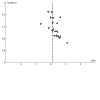











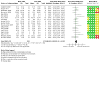

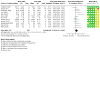
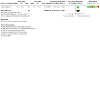

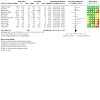
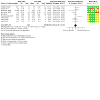

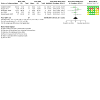
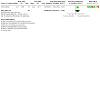
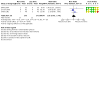
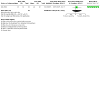


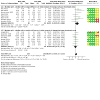

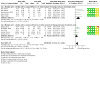
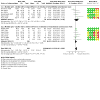
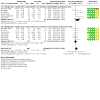
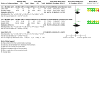
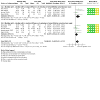
Update of
References
References to studies included in this review
Abdullahi 2018 {published and unpublished data}
Ada 2013 {published data only}
-
- Ada L, Dean C, Lindley R. Randomised trial of treadmill training to improve walking in community-dwelling people after stroke: the AMBULATE trial. International Journal of Stroke 2013;8:436-44. - PubMed
Burgar 2011 {published data only}
-
- Burgar C, Lum P, Scremin A, Garber S, Loos H, Kenney D and Shor P. Robot-assisted upper-limb therapy in acute rehabilitation setting following stroke: department of Veterans Affairs multisite clinical trial. Journal of Rehabilitation Research and Development 2011;48(4):445-58. - PubMed
Cooke 2010b {published data only}
-
- Cooke E, Tallis R, Clark A, Pomeroy V. Efficacy of functional strength training on restoration of lower-limb motor function early after stroke: phase I randomized controlled trial. Neurorehabilitation and Neural Repair 2010;24(1):88-96. - PubMed
Donaldson 2009 {published data only}
-
- Donaldson C, Tallis R, Miller S, Sunderland A, Lemon R, Pomeroy V. Effects of conventional physical therapy and functional strength training on upper limb motor recovery after stroke: a randomized phase II study. Neurorehabilitation and Neural Repair 2009;23(4):389-97. - PubMed
Dromerick 2009 {published data only}
English 2015 {published data only}
-
- English C, Bernhardt J, Crotty M, Esterman A, Segal L, Hillier S. Circuit class therapy or seven-day week therapy for increasing rehabilitation intensity of therapy after stroke (CIRCIT): a randomized controlled trial. International Journal of Stroke 2015;10(4):594-602. - PubMed
GAPS 2004 {published data only}
-
- Glasgow Augmented Physiotherapy Study (GAPS) group. Can augmented physiotherapy input enhance recovery of mobility after stroke? A randomized controlled trial. Clinical Rehabilitation 2004;18(5):529-37. - PubMed
Han 2013a {published data only}
-
- Han C, Wang Q, Meng P-P, Qi M-Z. Effects of intensity of arm training on hemiplegic upper extremity motor recovery in stroke patients: a randomized controlled trial. Clinical Rehabilitation 2013;27(1):75-81. - PubMed
Han 2013b {published data only}
-
- Han C, Wang Q, Meng P-P, Qi M-Z. Effects of intensity of arm training on hemiplegic upper extremity motor recovery in stroke patients: a randomized controlled trial. Clinical Rehabilitation 2013;27(1):75-81. - PubMed
Hsieh 2012 {published and unpublished data}
-
- Hsieh Y, Wu C, Lin K, Yao G, Wu K, Chang Y. Dose–response relationship of robot-assisted stroke motor rehabilitation: the impact of initial motor status. Stroke 2012;43(10):2729-34. - PubMed
Hsu 2010 {published data only}
-
- Hsu S, Hu M, Wang Y, Yip P, Chiu J, Hsieh C. Dose–response relation between neuromuscular electrical stimulation and upper-extremity function in patients with stroke. Stroke 2010;41(4):821-4. - PubMed
Hunter 2011a {published and unpublished data}
-
- Hunter S, Hammett L, Ball S, Smith N, Anderson C, Clark A, Tallis R, Rudd A and Pomeroy V. Dose–response study of mobilisation and tactile stimulation therapy for the upper extremity early after stroke: a phase I trial. Neurorehabilitation and Neural Repair 2011;25(4):314-22. - PubMed
Hunter 2011b {published and unpublished data}
-
- Hunter S, Hammett L, Ball S, Smith N, Anderson C, Clark A, Tallis R, Rudd A and Pomeroy V. Dose–response study of mobilisation and tactile stimulation therapy for the upper extremity early after stroke: a phase I trial. Neurorehabilitation and Neural Repair 2011;25(4):314-22. - PubMed
Kowalczewski 2007 {published data only}
-
- Kowalczewski J, Gritsenko V, Ashworth N, Ellaway P, Prochazka A. Upper-extremity functional electric stimulation-assisted exercises on a workstation in the subacute phase of stroke recovery. Archives of Physical Medicine and Rehabilitation 2007;88(7):833-9. - PubMed
Lang 2016a {published and unpublished data}
Lang 2016b {published data only}
Lang 2016c {published and unpublished data}
Lincoln 1999 {published data only}
-
- Lincoln N, Parry R, Vass C. Randomized, controlled trial to evaluate increased intensity of physiotherapy treatment of arm function after stroke. Stroke 1999;30(3):573-9. - PubMed
Page 2011 {published data only}
Page 2012a {published data only}
-
- Page S, Levin L, Hermann V, Dunning K, Levine P. Longer versus shorter daily durations of electrical stimulation during task-specific practice in moderately impaired stroke. Archives of Physical Medicine and Rehabilitation 2012;93(2):200-6. - PubMed
Page 2012b {published data only}
-
- Page S, Levin L, Hermann V, Dunning K, Levine P. Longer versus shorter daily durations of electrical stimulation during task-specific practice in moderately impaired stroke. Archives of Physical Medicine and Rehabilitation 2012;93(2):200-6. - PubMed
Partridge 2000 {published data only}
-
- Partridge C, Mackenzie M, Edwards S, Reid A, Jayawardena S, Guck N and Potter J. Is dosage of physiotherapy a critical factor in deciding patterns of recovery from stroke: a pragmatic randomized controlled trial. Physiotherapy Research International 2000;5(4):230-40. - PubMed
Smith 1981 {published data only}
Tong 2019 {published data only}
-
- Tong Y, Cheng Z, Rajah GB, Duan H, Cai L, Zhang N, Du H, Geng X and Ding Y. High intensity physical rehabilitation later than 24 h post stroke is beneficial in patients: a pilot randomized controlled trial (RCT) study in mild to moderate ischemic stroke. Frontiers in Neurology 2019;10:113. [DOI: 10.3389/fneur.2019.00113] - DOI - PMC - PubMed
Wang 2004 {published data only}
-
- Wang DS, Lu YY, Xie RM, Yao JR. Effect of different intensities of rehabilitation therapy on the prognosis of patients with stroke. Chinese Journal of Clinical Rehabilitation 2004;8(22):4410-1.
Wang 2011 {published data only}
-
- Wang Q, Zhao J, Zhu Q, Li J, Meng P. Comparison of conventional therapy, intensive therapy and modified constraint-induced movement therapy to improve upper extremity function after stroke. Journal of Rehabilitation Medicine 2011;43(7):619-25. - PubMed
Winstein 2019a {published and unpublished data}
-
- Winstein C, Kim B, Kim S, Martinez C, Schweighofer N. Dosage matters: a phase IIb randomized controlled trial of motor therapy in the chronic phase after stroke. Stroke 2019;50(7):1831-7. - PubMed
Winstein 2019b {published and unpublished data}
-
- Winstein C, Kim B, Kim S, Martinez C, Schweighofer N. Dosage matters: a phase IIb randomized controlled trial of motor therapy in the chronic phase after stroke. Stroke 2019;50(7):1831-7. - PubMed
References to studies excluded from this review
Abdullahi 2021 {published data only}
-
- Abdullahi A, Aliyu NU, Useh U, Abba MA, Akindele MO, Truijen S, et al. Effects of two different modes of task practice during lower limb constraint-induced movement therapy in people with stroke: a randomized clinical trial. Neural Plasticity 2021;2021:6664058. [DOI: 10.1155/2021/6664058] - DOI - PMC - PubMed
Abraha 2017 {published data only}
-
- Abraha B, Wadden KP, Wallack EM, Kelly LP, Mccarthy J, Ploughman M. Acute moderate continuous exercise, but not high intensity interval training, reduces the inhibitory influence of the contralesional hemisphere and affects hand movement in chronic stroke. International Journal of Stroke 2017;12(4 Suppl 1):46.
Afridi 2021 {published data only}
-
- Afridi A. Comparison of frequency & duration of task practice during constraint induced movement therapy. clinicaltrials.gov/ct2/show/NCT04757467 (first received 17 February 2021).
Agarwal 2008 {published data only}
-
- Agarwal V, Mukesh K, Kumar M, Ranjana P. Effect of number of repetitions of weight bearing exercises on time-distance parameters in stroke. Indian Journal of Physiotherapy and Occupational Therapy 2008;2(1):57-63.
Ardestani 2020 {published data only}
Askim 2004 {published data only}
-
- Askim T, Rohweder G, Lydersen S, Indredavik B. Evaluation of an extended stroke unit service with early supported discharge for patients living in a rural community. A randomized controlled trial. Clinical Rehabilitation 2004;18(3):238-48. - PubMed
Askim 2010 {published data only}
-
- Askim T, Mørkved S, Engen A, Roos K, Aas T, Indredavik B. Effects of a community-based intensive motor training program combined with early supported discharge after treatment in a comprehensive stroke unit: a randomized, controlled trial. Stroke 2010;41(8):1697-703. - PubMed
Bai 2008 {published data only}
-
- Bai Y, Hu Y, Chen W, Wang X, Cheng A, Jiang C, et al. Effects of three stage rehabilitation therapy on neurological deficit scores and ADL in ischemic stroke patients. Journal of Rehabilitation Medicine 2008;Suppl 46:109.
Bowden 2020 {published data only}
-
- Bowden MG, Monsch ED, Middleton A, Daughtry C, Powell T, Kraft SV. Lessons learned: the difficulties of incorporating intensity principles into inpatient stroke rehabilitation. Archives of Rehabilitation Research and Clinical Translation 2020;2(2):100052. [DOI: 10.1016/j.arrct.2020.100052] - DOI - PMC - PubMed
Boyd 2016 {published data only}
-
- Boyd L. The influence of exercise on neuroplasticity and motor learning after stroke (EX-ML3). clinicaltrials.gov/ct2/show/NCT02980796 (first received 2 December 2016).
Brusco 2014 {published data only}
-
- Brusco NK, Watts JJ, Shields N, Chan SP, Taylor NF. Does additional acute phase inpatient rehabilitation help people return to work? A subgroup analysis from a randomized controlled trial. Clinical Rehabilitation 2014;28(8):754-61. - PubMed
Byblow 2020 {published data only}
-
- Byblow W, Krakauer J, Stinear C, Barber P, Lee A, Kitago T. ESPRESSo: enhancing spontaneous recovery of hand and arm movement with high intensity therapy beginning one week after stroke. www.cochranelibrary.com/es/central/doi/10.1002/central/CN-02184407/full (accessed prior to 27 September 2021).
Byl 2008 {published data only}
-
- Byl N, Pitsch E, Abrams G. Functional outcomes can vary by dose: learning-based sensorimotor training for patients stable poststroke. Neurorehabilitation and Neural Repair 2008;22(5):494-504. - PubMed
Chen 2006 {published data only}
-
- Chen WH, Yu B, Xie XH, Tu XF. Application and cost-effectiveness analysis of three-stage rehabilitation program in treating acute stroke. Chinese Journal of Clinical Rehabilitation 2006;10(48):31-3.
Daly 2019 {published data only}
-
- Daly JJ, McCabe JP, Holcomb J, Monkiewicz M, Gansen J, Pundik S. Long-dose intensive therapy is necessary for strong, clinically significant, upper limb functional gains and retained gains in severe/moderate chronic stroke. Neurorehabilitation and Neural Repair 2019;33(7):523-37. [DOI: 10.1177/1545968319846120] - DOI - PMC - PubMed
de Sousa 2019 {published data only}
-
- Sousa DG, Harvey LA, Dorsch S, Varettas B, Jamieson S, Murphy A, et al. Two weeks of intensive sit-to-stand training in addition to usual care improves sit-to-stand ability in people who are unable to stand up independently after stroke: a randomised trial. Journal of Physiotherapy 2019;65(3):152-8. [DOI: 10.1016/j.jphys.2019.05.007] - DOI - PubMed
Di Lauro 2003 {published data only}
-
- Di Lauro A, Pellegrino L, Savastano G, Ferraro C, Fusco M, Balzarano F, et al. A randomized trial on the efficacy of intensive rehabilitation in the acute phase of ischemic stroke. Journal of Neurology 2003;250(10):1206-8. - PubMed
DRKS00023235 {published data only}
-
- DRKS00023235. Pilot study on the effects of an increased mobilization frequency on stroke patients in early neurological rehabilitation. www.cochranelibrary.com/central/doi/10.1002/central/CN-02240342/full (accessed prior to 27 September 2021).
Duff 2013 {published data only}
-
- Duff A, Nirme J, Rubio B, Duarte E, Cuxart A, Rodriguez S, et al. The optimal dosage of the rehabilitation gaming system: the impact of a longer period of virtual reality based and standard occupational training on upper limb recovery in the acute phase of stroke. Cerebrovascular Diseases 2013;35(Suppl 3):146.
Duncan 2003 {published data only}
-
- Duncan P, Studenski S, Richards L, Gollub S, Lai S, Reker D, et al. Randomized clinical trial of therapeutic exercise in subacute stroke. Stroke 2003;34(9):2173-80. - PubMed
Fasoli 2004 {published data only}
-
- Fasoli S, Krebs H, Ferraro M, Hogan N, Volpe B. Does shorter rehabilitation limit potential recovery poststroke? Neurorehabilitation and Neural Repair 2004;18(2):88-94. - PubMed
Forster 1992 {published data only}
-
- Forster A, Young J. Comparative cost-effectiveness of day hospital care and home rehabilitation for stroke patients. Clinical Rehabilitation 1992;6(Suppl):48.
Foucher 2017 {published data only}
-
- Foucher L. Comparison of fatigue and recovery after stroke depending on the usual management with or without physical training (FRAM). clinicaltrials.gov/ct2/show/NCT03259932 (first received 24 August 2017).
Galloway 2017 {published data only}
-
- Galloway M, Marsden D, Callister R, Niksson M, Erickson K, English C. Determining the minimum dose of exercise required to improve cardiorespiratory fitness in stroke survivors: protocol for the ExDose trial. International Journal of Stroke 2017;12(Suppl 2):27.
Gobbato 2012 {published data only}
-
- Gobbato S, Martins S. Very Early Rehabilitation in acute Ischemic Stroke (VERIS-Brazil). clinicaltrials.gov/ct2/show/NCT01694992 (first received 27 September 2012).
Green 2004 {published data only}
-
- Green J, Young J, Forster A, Collen F, Wade D. Combined analysis of two randomized trials of community physiotherapy for patients more than one year post stroke. Clinical Rehabilitation 2004;18(3):249-52. - PubMed
Henriksen 1992 {published data only}
-
- Henriksen IO, Ostergaard Laursen S. Acute stroke – treatment in a non-intensive stroke unit. Scandinavian Journal of Rehabilitation Medicine 1992;26(Suppl):153.
Hesse 2011 {published data only}
-
- Hesse S, Welz A, Werner C, Quentin B, Wissel J. Comparison of an intermittent high-intensity vs continuous low-intensity physiotherapy service over 12 months in community-dwelling people with stroke: a randomized trial. Clinical Rehabilitation 2011;25(2):146-56. - PubMed
Hogg 2020 {published data only}
-
- Hogg S, Holzgraefe M, Druge C, Hauschild F, Herrmann C, Obermann M, et al. High-intensity arm resistance training does not lead to better outcomes than low-intensity resistance training in patients after subacute stroke: a randomized controlled trial. Journal of Rehabilitation Medicine 2020;52(6):jrm00067. [DOI: 10.2340/16501977-2686] - DOI - PubMed
Hornby 2015 {published data only}
-
- Hornby T. Very Intensive Variable Repetitive AmbulatioN Training (VIVRANT). clinicaltrials.gov/ct2/show/NCT02507466 (first received 24 July 2015).
Hornby 2016 {published data only}
-
- Hornby TG, Holleran CL, Hennessy PW, Leddy AL, Connolly M, Camardo J, et al. Variable Intensive Early Walking Poststroke (VIEWS): a randomized controlled trial. Neurorehabilitation and Neural Repair 2016;30(5):440-50. - PubMed
Host 2014 {published data only}
Hsu 2016 {published data only}
-
- Hsu MJ. The effect of leg cycling exercise program at low or moderate intensity for individuals with subacute stroke. clinicaltrials.gov/ct2/show/NCT02855424 (first received 4 August 2016).
Hubbard 2010 {published data only}
-
- Hubbard IJ, Budd WT, Carey LM, Mcelduff P, Levi CR, Parsons MW. Intensive behavioural upper limb training in acute stroke: an RCT of functional outcomes and brain reorganisation. Cerebrovascular Diseases 2010;29(Suppl 2):63-4.
Huijben‐Schoenmakers 2014 {published data only}
-
- Huijben-Schoenmakers M, Rademaker A, Van Rooden P, Scherder E. The effects of increased therapy time on cognition and mood in frail patients with a stroke who rehabilitate on rehabilitation units of nursing homes in the Netherlands: a protocol of a comparative study. BMC Geriatrics 2014;14:68. - PMC - PubMed
Kissela 2013 {published data only}
-
- Kissela B, Dunning K. High Intensity Interval Training in chronic stroke (HIT). clinicaltrials.gov/ct2/show/NCT01958606 (first received 29 March 2017).
Klassen 2020 {published data only}
-
- Klassen T, Eng JJ, Bayley M, Benavente O, Krassioukov A, Piitz M, et al. Determining optimal post-stroke exercise (DOSE): study protocol for a randomized controlled trial investigating exercise intensity during inpatient rehabilitation. International Journal of Stroke 2017;12( Suppl 1):57-8. - PubMed
Kosak 1998 {published data only}
-
- Kosak M, Reding M. Early aggressive mobilization is as effective as treadmill training for ambulation recovery in patients with stroke. Journal of Stroke and Cerebrovascular Diseases 1998;7:372.
Krebs 1997 {published data only}
-
- Krebs H, Hogan N. Clinical test of robot-aided stroke rehabilitation. Journal of Stroke and Cerebrovascular Diseases 1997;6(3):145.
Lamberti 2017 {published data only}
-
- Lamberti N, Straudi S, Malagoni A, Argiro M, Felisatti M, Nardini E, et al. Effects of low-intensity endurance and resistance training on mobility in chronic stroke survivors: a pilot randomized controlled study. European Journal of Physical and Rehabilitation Medicine 2017;53(2):228-39. - PubMed
Langhammer 2007 {published data only}
-
- Langhammer B, Lindmark B, Stanghelle J. Stroke patients and long-term training: is it worthwhile: a randomized comparison of two different training strategies after rehabilitation. Clinical Rehabilitation 2007;21(6):495-510. - PubMed
Langhammer 2014 {published data only}
-
- Langhammer B, Lindmark B, Stanghelle J. Physiotherapy and physical functioning post-stroke: exercise habits and functioning 4 years later? Long-term follow-up after a 1-year long-term intervention period: a randomized controlled trial. Brain Injury 2014;28(11):1396–405. - PubMed
Langhorne 2010 {published data only}
-
- Langhorne P, Stott D, Knight A, Bernhardt J, Barer D, Watkins C. Very early rehabilitation or intensive telemetry after stroke: a pilot randomised trial. Cerebrovascular Diseases 2010;29(4):352-60. - PubMed
Langhorne 2017 {published data only}
Lee 2012 {published data only}
Lewthwaite 2018 {published data only}
-
- Lewthwaite R, Winstein CJ, Lane CJ, Blanton S, Wagenheim BR, Nelsen MA, et al. Accelerating stroke recovery: body structures and functions, activities, participation, and quality of life outcomes from a large rehabilitation trial. Neurorehabilitation and Neural Repair 2018;32(2):150-65. - PMC - PubMed
Li 2000 {published data only}
-
- Li L, Yuan J, Zhang C. Clinical observation on hemiplegic patients with functional electric stimulation and intensive training on their lower extremities. Chinese Journal of Physical Medicine and Rehabilitation 2000;22(1):18-9.
Lin 2017 {published data only}
-
- Lin Y. Does the enhanced rehabilitation programs facilitate the motor recovery after stroke? clinicaltrials.gov/ct2/show/NCT03230370 (first received 26 July 2017).
Lo 2010 {published data only}
-
- Lo A. VA ROBOTICS published: high-intensity therapy aids recovery of function, QOL in chronic stroke. www.medscape.com/viewarticle/720573 (accessed prior to 27 September 2021). [https://www.medscape.com/viewarticle/720573]
Logan 1997 {published data only}
-
- Logan PA, Ahern J, Gladman JR, Lincoln NB. A randomized controlled trial of enhanced social service occupational therapy for stroke patients. Clinical Rehabilitation 1997;11:107-13. - PubMed
Malouin 1992 {published data only}
-
- Malouin F, Potvin M, Prevost J, Richards CL, Wood-Dauphinee S. Use of intensive task-oriented gait training program in a series of patients with acute cerebrovascular accidents. Physical Therapy 1992;72(11):789-93. - PubMed
Malouin 1993 {published data only}
-
- Malouin F, Richards C, Wood-Dauphinee S, Ivan Williams J. A randomized controlled trial comparing early and intensive task-specific therapy to conventional therapy in acute-stroke patients. Canadian Journal of Rehabilitation 1993;7(1):27-8.
Martinsson 2003 {published data only}
-
- Martinsson L, Eksborg S, Wahlgren N. Intensive early physiotherapy combined with dexamphetamine treatment in severe stroke: a randomized, controlled pilot study. Cerebrovascular Diseases 2003;16(4):338-45. - PubMed
Marzolini 2016 {published data only}
-
- Marzolini S, Kangatharan S, Koblinsky N, Oh P. High intensity interval training for people with stroke deficits (HIIT-Stroke). clinicaltrials.gov/ct2/show/NCT03006731 (first received 30 December 2016).
McDonnell 2017 {published data only}
-
- McDonnell MN, Serrada I, Hillier SL. Increasing the amount of upper extremity rehabilitation in the first four weeks following stroke: a feasibility study. Stroke 2017;48(Suppl 1):TMP39.
Mickelborough 1999 {published data only}
-
- Mickelborough J, Liston R, Harris B, Wynn Hann A, Tallis RC. An evaluation of conventional physiotherapy and treadmill re-training of higher-level gait disorders in patients with cerebral multi-infarct states. Age and Ageing 1999;28(Suppl 2):54.
Mikulecka 2005 {published data only}
-
- Mikulecka E, Petruskova L, Mayer M, Vlachova I. Differentiated manual treatment of the hand and forearm in the early rehabilitation of stroke patients (a controlled study). Rehabilitacia Bratislava 2005;42(1):52-61.
Outermans 2010 {published data only}
-
- Outermans J, Peppen RP, Wittink H, Takken T, Kwakkel G. Effects of a high-intensity task-oriented training on gait performance early after stroke: a pilot study. Clinical Rehabilitation 2010;24(11):979-87. - PubMed
Ozdemir 2001 {published data only}
-
- Ozdemir F, Birtane M, Tabatabaei R, Kokino S, Ekuklu G. Comparing stroke rehabilitation outcomes between acute inpatient and nonintense home settings. Archives of Physical Medicine and Rehabilitation 2001;82:1375-9. - PubMed
Raghavan 2016 {published data only}
-
- Raghavan P, Aluru V, Palumbo A, Battaglia J, Kwon S, Ogedegbe G. Creating an enriched rehabilitation environment in a low-resource setting. International Journal of Stroke 2016;11(Suppl 3):36.
Richards 2006a {published data only}
-
- Richards L, Rothi L, Davis S, Wu S, Nadeau S. Limited dose response to constraint-induced movement therapy in patients with chronic stroke. Clinical Rehabilitation 2006;20(12):1066-74. - PubMed
Richards 2006b {published data only}
-
- Richards L. The effect of different schedules of functional task practice for improving hand and arm function after stroke. clinicaltrials.gov/ct2/show/NCT00361660 (first received 8 August 2006). [https://clinicaltrials.gov/ct2/show/NCT00361660]
Roderick 2001 {published data only}
-
- Roderick P, Low J, Day R, Peasgood T, Mullee M, Turnbull J, et al. Stroke rehabilitation after hospital discharge: a randomized trial comparing domiciliary and day-hospital care. Age and Ageing 2001;30(4):303-10. - PubMed
Rodgers 2019 {published data only}
Ruff 1999 {published data only}
-
- Ruff R, Yarnell S, Marinos J. Are stroke patients discharged sooner if in-patient rehabilitation services are provided seven v six days per week? American Journal of Physical Medicine and Rehabilitation 1999;78(2):143-6. - PubMed
Ryan 2006 {published data only}
-
- Ryan T, Enderby P, Rigby AS. A randomized controlled trial to evaluate intensity of community-based rehabilitation provision following stroke or hip fracture in old age. Clinical Rehabilitation 2006;20(2):123-31. - PubMed
Sanchez‐Sanchez 2015 {published data only}
-
- Sanchez-Sanchez ML, Belda-Lois JM, Viosca-Herrero E, Igual-Camacho C, Gisbert-Morant B and Mena-del S. Analysis of the effect of using two physiotherapy protocols in balance recovery after stroke using a novel methodology of functional principal components. Cerebrovascular Diseases 2015;39(Suppl 2):322.
Scrivener 2012 {published data only}
-
- Scrivener K, Sherrington C, Schurr K. Amount of exercise in the first week after stroke predicts walking speed and unassisted walking. Neurorehabilitation and Neural Repair 2012;26(8):932-8. - PubMed
Sheil 2001 {published data only}
-
- Shiel A, Burn J, Henry D, Clark J, Wilson B, Burnett M, et al. The effects of increased rehabilitation therapy after brain injury: results of a prospective controlled trial. Clinical Rehabilitation 2001;15(5):501-14. - PubMed
Sivenius 1985 {published data only}
-
- Sivenius J, Pyörälä K, Heinonen OP, Salonen JT, Riekkinen P. The significance of intensity of rehabilitation of stroke-a controlled trial. Stroke 1985;16(6):928-31. - PubMed
Slade 2002 {published data only}
-
- Slade A, Tennant A, Chamberlain M. A randomised controlled trial to determine the effect of intensity of therapy upon length of stay in a neurological rehabilitation setting. Journal of Rehabilitation Medicine 2002;34(6):260-6. - PubMed
Sonoda 2004 {published data only}
-
- Sonoda S, Saitoh E, Nagai S, Kawakita M, Kanada Y. Full-time integrated treatment program, a new system for stroke rehabilitation in Japan: comparison with conventional rehabilitation. American Journal of Physical Medicine and Rehabilitation 2004;83(2):88-93. - PubMed
Sterr 2002 {published data only}
-
- Sterr A, Elbert T, Berthold I, Kolbel S, Rockstroh B. Longer versus shorter daily constraint-induced movement therapy of chronic hemiparesis: a exploratory study. Archives of Physical Medicine and Rehabilitation 2002;83:1374-7. - PubMed
Sunderland 1992 {published data only}
Tomic 2017 {published data only}
van Wijck 2020 {published data only}
-
- Wijck F, Alexander G, Baillie L, Bain B, Barber M, Dall P, et al. Early VERsus Later Augmented Physiotherapy compared with usual physiotherapy (EVERLAP): a feasibility randomised controlled trial of arm function after stroke. Physiotherapy 2020;107(Suppl 1):e13-e14. [DOI: 10.1016/j.physio.2020.03.021] - DOI
Wu 2016 {published data only}
-
- Wu X, Guarino P, Lo AC, Peduzzi P, Wininger M. Long-term effectiveness of intensive therapy in chronic stroke. Neurorehabilitation and Neural Repair 2016;30(6):583-90. - PubMed
Wuennemann 2020 {published data only}
-
- Wuennemann MJ, Mackenzie SW, Lane HP, Peltz AR, Ma X, Gerber LM, et al. Dose and staffing comparison study of upper limb device-assisted therapy. NeuroRehabilitation 2020;46(3):287-97. - PubMed
Xu 2008 {published data only}
-
- Xu Y. The effect of early intensive exercise on patients with hemiplegia. Journal of Rehabilitation Medicine 2008;Suppl 46:75.
Yau 2010 {published data only}
-
- Yau W, Wong W. The feasibility and efficacy of an augmented exercise program for acute stroke patients. International Journal of Stroke 2010;5(Suppl 2):346-7.
Yelnik 2017 {published data only}
-
- Yelnik A, Quintaine V, Andriantsifanetra C, Wannepain M, Reiner P, Marnef H, et al. AMOBES (Active Mobility Very Early after Stroke): a randomized controlled trial. Stroke 2017;48(2):400-5. - PubMed
Yu 2008 {published data only}
-
- Yu J, Hu Y, Wu Y, Chen W, Cui X, Lu W, et al. An analysis about the effects of standardized community-based rehabilitation (CBR) therapy on ADL for patients after stroke in China. Journal of Rehabilitation Medicine 2008;Suppl 46:110.
Zhang 2005 {published data only}
-
- Zhang DJ, Zhu SW, Cui GX, Liu SJ, Li YZ. Difference between early and late rehabilitative intervention in ameliorating the motor function and activities of daily living in patients with cerebral infarction. Chinese Journal of Clinical Rehabilitation 2005;9(33):149-51.
References to studies awaiting assessment
Aksu 2001 {published data only}
-
- Aksu S, Armutlu K, Cetisli N, Guclu A, Atay S, Guniken Y, et al. Numbers of exercises in acute stroke rehabilitation: is it important? Neurorehabilitation and Neural Repair 2001;15(4):348.
Cauraugh 2006 {published data only}
-
- Cauraugh JH. Effects of different amounts of electrical stimulation + bilateral practice on improving hand function after stroke. clinicaltrials.gov/ct2/show/NCT00369668 (first received 29 August 2006).
Hsieh 2011 {published data only}
-
- Hsieh Y, Wu C, Liao W, Lin K, Wu K, Lee C. Effects of treatment intensity in upper limb robot-assisted therapy for chronic stroke: a pilot randomized controlled trial. Neurorehabilitation and Neural Repair 2011;25(6):503-11. - PubMed
Jung 2008 {published data only}
-
- Jung HY, Yeo SW, Park BK. Influences of the amount of rehabilitation training on the functional improvement after stroke. International Journal of Stroke 2008;3(Suppl 1):345.
Kreisel 2005 {published data only}
-
- Kreisel SH, Bazner H, Hennerici MG. Intensive rehabilitation in the acute phase of stroke: positive or negative effects on outcome? Cerebrovascular Diseases 2005;19(Suppl 2):92.
Rimmer 2004 {published data only}
-
- Rimmer J, Wang E. The dose–response effects on aerobic exercise in stroke survivors. Archives of Physical Medicine and Rehabilitation 2004;85(8):E2.
Takebayashi 2015 {published data only}
-
- Takebayashi T, Takahashi K, Domen K, Hachisuka K, Kimura T. Efficient training intensity of robotic therapy to improve arm function in subacute stroke patients. Cerebrovascular Diseases 2015;39(Suppl 2):260.
Wu 2013 {published data only}
-
- Wu CW. Effects of intensive robot-assisted therapy in patients with subacute stroke (RT). clinicaltrials.gov/ct2/show/NCT01767480 (first received 14 January 2013).
References to ongoing studies
Bernhardt 2019 {published data only}
-
- Bernhardt J, Churilov L, Langhorne P, Pandian J, Dewey H, Shrikanth V, the AVERT DOSE Trialist Collaboration. Ongoing trial update 2019: determining optimal early rehabilitation after stroke (AVERT DOSE). European Stroke Journal 2019;4(Suppl 1):816. [DOI: 10.1177/2396987319848124] - DOI
-
- Bernhardt J. A phase 3, multi arm, multi stage, covariate adjusted, response adaptive, randomised trial to determine optimal early mobility training after stroke. www.anzctr.org.au/Trial/Registration/TrialReview.aspx?id=376646 (first received 10 April 2019). - PubMed
Chang 2015 {published data only}
-
- NCT03168360. Effect of intensive cognitive rehabilitation in subacute stroke patient. clinicaltrials.gov/ct2/show/NCT03168360 (first received 30 May 2017).
Dukelow 2019 {published data only}
-
- Dukelow S. Robot-Enhanced Stroke Therapy Optimizes Rehabilitation (RESTORE). clinicaltrials.gov/ct2/show/NCT04201613 (first received 17 December 2019). [https://clinicaltrials.gov/ct2/show/NCT04201613]
Holmstedt 2021 {published data only}
-
- Holmstedt C. Impact of more frequent PT services. clinicaltrials.gov/ct2/show/NCT04778475 (first received 3 March 2021).
Kanlaya 2018 {published data only}
-
- Kanlaya S. Effects of the Accelerated Skill Acquisition Program (ASAP) training duration on reach-to-grasp performance in individuals with subacute stroke (effects of ASAP duration on UE training for stroke). https://www.thaiclinicaltrials.org/show/TCTR20180316004. [www.who.int/trialsearch/Trial2.aspx?TrialID=TCTR20180316004]
Kinoshita 2020 {published data only}
Ling 2018 {published data only}
-
- Ling H. Effect of different intensity rehabilitation training on hemiplegic patients after stroke. www.chictr.org.cn/showproj.aspx?proj=28656 (first received 28 June 2018). [http://www.who.int/trialsearch/Trial2.aspx?TrialID=ChiCTR1800016841]
Mansfield 2020 {published data only}
-
- Mansfield A. Determining the optimal dose of reactive balance training after stroke. clinicaltrials.gov/ct2/show/NCT04219696 (first received 7 January 2020). [https://www.clinicaltrials.gov/ct2/show/NCT04219696]
Additional references
Arya 2011
-
- Arya KN, Verma R, Garg RK. Estimating the minimal clinically important difference of an upper extremity recovery measure in subacute stroke patients. Topics in Stroke Rehabilitation 2011;18(Suppl 1):599-610. - PubMed
Bahalla 2021
-
- Bahalla A, James M, Stanley K, Ralph S, Durante N, Mcmullen E, et al. Springboard for Progress: the Seventh SSNAP Annual Report. London (UK): Healthcare Quality Improvement Partnership (HQIP), 2021.
Ballinger 1999
-
- Ballinger C, Ashburn A, Low J, Roderick P. Unpacking the black box of therapy – a pilot study to describe occupational therapy and physiotherapy interventions for people with stroke. Clinical Rehabilitation 1999;13(4):301-9. - PubMed
Bhaskar 2017
-
- Bhaskar S, Stanwell P, Bivard A, Spratt N, Walker R, Kitsos GH, et al. The influence of initial stroke severity on mortality, overall functional outcome and in-hospital placement at 90 days following acute ischemic stroke: a tertiary hospital stroke register study. Neurology India 2017;65(6):1252-9. [DOI: 10.4103/0028-3886.217947] - DOI - PubMed
Bohannon 2019
Bowen 2013
Boyd 2003
-
- Boyd LA, Winstein CJ. Impact of explicit information on implicit motor-sequence learning following middle cerebral artery stroke. Physical Therapy 2003;83(11):976-89. - PubMed
Boyd 2004
Bramer 2016
Brott 1989
-
- Brott T, Adams HP, Olinger CP, Marler JR, Barsan WG, Biller J, et al. Measurements of acute cerebral infarction: a clinical examination scale. Stroke 1989;20:864-70. [DOI: ] - PubMed
Buma 2013
-
- Buma F, Kwakkel G, Ramsey N. Understanding upper limb recovery after stroke. Restorative Neurology and Neuroscience 2013;31(6):707-22. - PubMed
Chen 2019
Cheng 2015
Chung 2013
-
- Chung CS, Pollock A, Campbell T, Durward BR, Hagen S. Cognitive rehabilitation for executive dysfunction in adults with stroke or other adult non-progressive acquired brain damage. Cochrane Database of Systematic Reviews 2013, Issue 4. Art. No: CD008391. [DOI: 10.1002/14651858.CD008391.pub2] - DOI - PMC - PubMed
Cohen 1988
-
- Cohen J. Statistical Power Analysis in the Behavioral Sciences. 2nd edition. Hillsdale (NJ): Lawrence Erlbaum Associates, Inc., 1988.
Concato 2010
-
- Concato J, Lawler EV, Lew RA, Gaziano JM, Aslan M, Huang GD. Observational methods in comparative effectiveness research. American Journal of Medicine 2010;123(12 Suppl 1):e16-23. - PubMed
Cooke 2010a
-
- Cooke EV, Tallis RC, Clark A, Pomeroy VM. Efficacy of functional strength training on restoration of lower-limb motor function early after stroke: phase I randomized controlled trial. Neurorehabilitation and Neural Repair 2010;24(1):88-96. - PubMed
Corbetta 2015
das Nair 2016
Deeks 2021
-
- Deeks JJ, Higgins JP, Altman DG. Chapter 10: Analysing data and undertaking meta-analyses. In: Higgins JP, Thomas J, Chandler J, Cumpston M, Li T, Page MJ, et al, editors(s). Cochrane Handbook for Systematic Reviews of Interventions Version 6.2 (updated February 2021). Chichester (UK): John Wiley & Sons, 2021. [AVAILABLE FROM: www.training.cochrane.org/handbook]
DeJong 2005
-
- DeJong G, Horn SD, Conroy B, Nichols D, Healton EB. Opening the black box of post-stroke rehabilitation: stroke rehabilitation patients, processes, and outcomes. Archives of Physical Medicine and Rehabilitation 2005;86(12 Suppl 2):S1-7. - PubMed
Devereaux 2003
-
- Devereaux PJ, Yusuf S. The evolution of the randomized controlled trial and its role in evidence-based decision making. Journal of Internal Medicine 2003;254:105-13. - PubMed
Dobkin 2005
-
- Dobkin BH, Carmichael TS. Principles of recovery after stroke. In: Barnes MP, Dobkin BH, Bogousslavsky J, editors(s). Recovery After Stroke. Cambridge (UK): Cambridge University Press, 2005:47-66.
Douiri 2013
Dromerick 2009
Duncan 1994
-
- Duncan P, Goldstein LB, Horner RD, Landsman PB, Samsa GP, Matchar M. Similar motor recovery of upper and lower extremities after stroke. Stroke 1994;25(6):1181-8. - PubMed
Engelter 2006
-
- Engelter ST, Gostynski M, Papa A, Frei M, Born C, Ajdacic‐Gross V, et al. Epidemiology of aphasia attributable to first ischemic stroke: incidence, severity, fluency, etiology, and thrombolysis. Stroke 2006;37(6):1379‐84. - PubMed
French 2016
Galvin 2008
-
- Galvin R, Murphy B, Cusack T, Stokes E. The impact of increased duration of exercise therapy on functional recovery following stroke: what is the evidence? Topics In Stroke Rehabilitation 2008;15(4):365-77. - PubMed
GBD 2016 Stroke Collaborators 2019
Guadagnoli 2004
-
- Guadagnoli MA, Lee TD. Challenge point: a framework for conceptualizing the effects of various practice conditions in motor learning. Journal of Motor Behavior 2004;36(2):212-4. - PubMed
Guyatt 2011
Hanlon 1996
-
- Hanlon RE. Motor learning following unilateral stroke. Archives of Physical Medicine & Rehabilitation 1996;77(8):811-5. - PubMed
Hao 2013
Hebb 1949
-
- Hebb DO. The Organization of Behavior. New York (NY): Wiley & Sons, 1949.
Higgins 2003
Higgins 2021a
-
- Higgins JP, Savović J, Page MJ, Elbers RG, Sterne JA. Chapter 8: Assessing risk of bias in a randomized trial. In: Higgins JP, Thomas J, Chandler J, Cumpston M, Li T, Page MJ, et al, editors(s). Cochrane Handbook for Systematic Reviews of Interventions Version 6.2 (updated February 2021). Chichester (UK): John Wiley & Sons, 2021. [AVAILABLE FROM: www.training.cochrane.org/handbook]
Higgins 2021b
-
- Higgins JP, Eldridge S, Li T. Chapter 23: Including variants on randomized trials. In: Higgins JP, Thomas J, Chandler J, Cumpston M, Li T, Page MJ, et al, editors(s). Cochrane Handbook for Systematic Reviews of Interventions Version 6.2 (updated February 2021). Chichester (UK): John Wiley & Sons, 2021. [AVAILABLE FROM: www.training.cochrane.org/handbook.]
Hoffmann 2014
-
- Hoffmann TC, Glasziou PP, Boutron I, Milne R, Perera R, Moher D, et al. Better reporting of interventions: template for intervention description and replication (TIDieR) checklist and guide. BMJ 2014;348(3):g1687. - PubMed
Horn 2005
-
- Horn SD, Dejong G, Ryser DK, Veazie PJ, Teraoka J. Another look at observational studies in rehabilitation research: going beyond the holy grail of the randomized controlled trial. Archives of Physical Medicine and Rehabilitation 2005;86(Suppl 2):S8-S15. - PubMed
ICSWP 2016
-
- Intercollegiate Stroke Working Party. National Clinical Guideline for Stroke. Fifth edition. London (UK): Royal College of Physicians, 2016.
Janssen 2010
-
- Janssen H, Bernhardt J, Collier JM, Sena ES, McElduff P, Attia J, et al. An enriched environment improves sensorimotor function post-ischemic stroke. Neurorehabilitation and Neural Repair 2010;24(9):802-13. - PubMed
Jette 2005
-
- Jette DU, Latham NK, Smout RJ, Gassaway J, Slavin MD, Horn SD. Physical therapy interventions for patients with stroke in inpatient rehabilitation facilities. Physical Therapy 2005;85(3):238-48. - PubMed
Kersten 2010
-
- Kersten P, Ellis-Hill C, Mcpherson KM, Harrington R. Beyond the RCT – understanding the relationship between interventions, individuals and outcome – the example of neurological rehabilitation. Disability and Rehabilitation 2010;32(12):1028-34. - PubMed
Kim 2014
Kitago 2013
-
- Kitago T, Krakauer JW. Motor learning principles for neurorehabilitation. Handbook of Clinical Neurology 2013;110:93-103. - PubMed
Klassen 2020
-
- Klassen TD, Dukelow SP, Bayley MT, Benavente O, Hill MD, Krassioukov A, et al. Higher doses improve walking recovery during stroke inpatient rehabilitation. Stroke 2020;51(9):2639-48. - PubMed
Kleim 2008
-
- Kleim JA, Jones TA. Principles of experience-dependent neural plasticity: implications for rehabilitation after brain damage. Journal of Speech, Language and Hearing Research 2008;51(1):s225-39. - PubMed
Kwakkel 1997
-
- Kwakkel G, Wagenaar RC, Koelman TW, Lankhorst GJ, Koetsier JC. Effects of intensity of rehabilitation after stroke. A research synthesis. Stroke 1997;28(8):1550-6. - PubMed
Kwakkel 2004
-
- Kwakkel G, Peppen R, Wagenaar RC, Dauphinee SW, Richards C, Ashburn A, et al. Effects of augmented exercise therapy time after stroke: a meta-analysis. Stroke 2004;35(11):2529-36. - PubMed
Kwakkel 2015
Lang 2008
Langhorne 1996
-
- Langhorne P, Wagenaar R, Partridge C. Physiotherapy after stroke: more is better? Physiotherapy Research International 1996;1(2):75-88. - PubMed
Laver 2013
Laver 2015
Levack 2006
-
- Levack WM, Taylor K, Siegert RJ, Dean SG, Mcpherson KM, Weatherall M. Is goal planning in rehabilitation effective? A systematic review. Clinical Rehabilitation 2006;20(9):739-55. - PubMed
Levin 2009
-
- Levin MF, Kleim JA, Wolf SL. What do motor "recovery" and "compensation" mean in patients following stroke? Neurorehabilitation and Neural Repair 2009;23(4):313-9. - PubMed
Lewthwaite 2018
Lo 2010
Loetscher 2013
Lohse 2014
Lui 2018
Ma 1999
-
- Ma H, Trombly CA, Robinson-Podolski C. The effect of context on skill acquisition and transfer. American Journal of Occupational Therapy 1999;53(2):138-44. - PubMed
McCabe 2015
-
- McCabe J, Monkiewicz M, Holcomb J, Pundik S, Daly JJ. Comparison of robotics, functional electrical stimulation, and motor learning methods for treatment of persistent upper extremity dysfunction after stroke: a randomized controlled trial. Archives of Physical Medicine and Rehabilitation 2015;96(6):981-90. [DOI: 10.1016/j.apmr.2014.10.022] - DOI - PubMed
Mehrholz 2018
-
- Mehrholz J, Pohl M, Platz T, Kugler J, Elsner B. Electromechanical and robot-assisted arm training for improving activities of daily living, arm function, and arm muscle strength after stroke. Cochrane Database of Systematic Reviews 2018, Issue 9. Art. No: CD006876. [DOI: 10.1002/14651858.CD006876.pub5] - DOI - PMC - PubMed
Moher 2009
Mount 2007
-
- Mount J, Pierce SR, Parker J, Diegidio R, Woessner R, Spiegel L. Trial and error versus errorless learning of functional skills in patients with acute stroke. Neurorehabilitation 2007;22(2):123-32. - PubMed
Mozaffarian 2015
-
- Mozaffarian D, Benjamin E, Go A, Arnett D, Blaha M, Cushman M, et al. Heart disease and stroke statistics – 2015 update: a report from the American Heart Association. Circulation 2015;131(4):e29-e322. - PubMed
NICE 2013
-
- National Institute for Health and Care Excellence. Stroke Rehabilitation: Long Term Rehabilitation after Stroke. Manchester (UK): National Institute for Health and Care Excellence, 2013.
Nudo 2013
Outermans 2010
-
- Outermans J, Peppen R, Wittink H, Takken T, Kwakkel G. Effects of a high-intensity task-oriented training on gait performance early after stroke: a pilot study. Clinical Rehabilitation 2010;24(11):979-87. - PubMed
Oyewole 2020
-
- Oyewole OO, Ogunlana MO, Gbiri CA, Oritogun KS, Osalusi BS. Impact of post-stroke disability and disability-perception on health-related quality of life of stroke survivors: the moderating effect of disability-severity. Neurological Research 2020;42(10):835-43. [DOI: 10.1080/01616412.2020.1785744] - DOI - PubMed
Page 2012
-
- Page SJ, Fulk GD, Boyne P. Clinically important differences for the upper-extremity Fugl-Meyer scale in people with minimal to moderate impairment due to chronic stroke. Physical Therapy 2012;92(6):791-8. - PubMed
Page 2021
-
- Page MJ, Higgins JP, Sterne JA. Chapter 13: Assessing risk of bias due to missing results in a synthesis. In: Higgins JP, Thomas J, Chandler J, Cumpston M, Li T, Page MJ, et al, editors(s). Cochrane Handbook for Systematic Reviews of Interventions Version 6.2 (updated February 2021). Chichester (UK): John Wiley & Sons, 2021. [AVAILABLE FROM: www.training.cochrane.org/handbook]
Patel 2020
Pollock 2014a
Pollock 2014b
RevMan Web 2019 [Computer program]
-
- Review Manager Web (RevMan Web). The Cochrane Collaboration, 2019. Available at: revman.cochrane.org.
RoB 2 Guidance 2019
-
- Higgins JP, Savović J, Page MJ, Sterne JA, the RoB 2 Development Group. Revised Cochrane risk-of-bias tool for randomized trials (RoB 2) (full guidance document, 22 August 2019). Available from: www.riskofbias.info/welcome/rob-2-0-tool (accessed 6 September 2019).
Rodgers 2003
Rost 2016
-
- Rost NS, Bottle A, Lee JM, Randall M, Middleton S, Shaw L, the Global Comparators Stroke GOAL collaborators. Stroke severity is a crucial predictor of outcome: an international prospective validation study. Journal of the American Heart Association 2016;5:e002433. [DOI: 10.1161/JAHA.115.002433] - DOI - PMC - PubMed
Royal College of Physicians 2014
-
- Royal College of Physicians. How Good is Stroke Care? First SSNAP Annual Report. London (UK): Royal College of Physicians, 2014.
Sacco 2013
-
- Sacco RL, Kasner SE, Broderick JP, Caplan LR, Connors JJ, Culebras A, American Heart Association Stroke Council COCS , Anesthesia, Council on Cardiovascular R , Intervention, Council On C , Stroke N, Council On E , Prevention, Council on Peripheral Vascular D , Council on Nutrition PA and Metabolism. An updated definition of stroke for the 21st century: a statement for healthcare professionals from the American Heart Association/American Stroke Association. Stroke 2013;44(7):2064-89. - PMC - PubMed
Saunders 2020
Schneider 2016
-
- Schneider EJ, Lannin NA, Ada L, Schmidt J. Increasing the amount of usual rehabilitation improves activity after stroke: a systematic review. Journal of Physiotherapy 2016;62(4):182-7. - PubMed
Schünemann 2013
-
- Schünemann H, Brożek J, Guyatt G, Oxman A, editor(s). Handbook for grading the quality of evidence and the strength of recommendations using the GRADE approach (updated October 2013). GRADE Working Group, 2013. Available from gdt.guidelinedevelopment.org/app/handbook/handbook.html.
Schünemann 2021a
-
- Schünemann HJ, Higgins JP, Vist GE, Glasziou P, Akl EA, Skoetz N, et al. Chapter 14: Completing 'Summary of findings' tables and grading the certainty of the evidence. In: Higgins JP, Thomas J, Chandler J, Cumpston M, Li T, Page MJ, et al, editors(s). Cochrane Handbook for Systematic Reviews of Interventions Version 6.2 (updated February 2021). Chichester (UK): John Wiley & Sons, 2021.
Schünemann 2021b
-
- Schünemann HJ, Vist GE, Higgins JP, Santesso N, Deeks JJ, Glasziou P, et al. Chapter 15: Interpreting results and drawing conclusions. In: Higgins JP, Thomas J, Chandler J, Cumpston M, Li T, Page MJ, et al, editors(s). Cochrane Handbook for Systematic Reviews of Interventions Version 6.2 (updated February 2021). Chichester (UK): John Wiley & Sons, 2021.
Scrivener 2012
-
- Scrivener K, Sherrington C, Schurr K. Amount of exercise in the first week after stroke predicts walking speed and unassisted walking. Neurological Rehabilitation and Neural Repair 2012;26(8):932-8. - PubMed
Sehatzadeh 2015
Sterne 2019
Stroke Foundation 2021
-
- Stroke Foundation. Clinical Guidelines for Stroke Management. https://app.magicapp.org/#/guideline/5493/section/80895 [Accessed 19th September 2021] 2021.
Teasell 2020
-
- Teasell R, Salbach NM, Foley N, Mountain A, Cameron JI, Jong A, Acerra NE, Bastasi D, Carter SL, Fung J, Halabi ML, Iruthayarajah J, Harris J, Kim E, Noland A, Pooyania S, Rochette A, Stack BD, Symcox E, Timpson D, Varghese S, Verrilli S, Gubitz G, Casaubon LK, Dowlatshahi D and Lindsay MP. Canadian Stroke Best Practice Recommendations: Rehabilitation, Recovery, and Community Participation following Stroke. Part One: Rehabilitation and Recovery Following Stroke; 6th Edition Update 2019. International journal of stroke: official journal of the International Stroke Society 2020;15(7):763-788. [DOI: 10.1177/1747493019897843] - DOI - PubMed
Thieme 2018
van der Vliet 2020
van Kordelaar 2013
-
- Kordelaar J, Wegen EE, Nijland RH, Daffertshofer A, Kwakkel G. Understanding adaptive motor control of the paretic upper limb early poststroke: the EXPLICIT-stroke program. Neurorehabilitation and Neural Repair 2013;27(9):854-63. - PubMed
van Vliet 2006
-
- Vliet PM, Wulf G. Extrinsic feedback for motor learning after stroke: what is the evidence? Disability Rehabilitation 2006;28(13-14):831-40. - PubMed
Veerbeek 2011
-
- Veerbeek JM, Koolstra M, Ket JC, Van Wegen EE, Kwakkel G. Effects of augmented exercise therapy on outcome of gait and gait-related activities in the first 6 months after stroke: a meta-analysis. Stroke 2011;42(11):3311-5. - PubMed
Veerbeek 2014
Ward 2019
Whitall 2011
WHO 2001
-
- World Health Organization. International Classification of Functioning, Disability and Health. Geneva (Switzerland): World Health Organization, 2001.
Winstein 1990
-
- Winstein CJ, Schmidt RA. Reduced frequency of knowledge of results enhances motor skill learning. Journal of Experimental Psychology: Learning, Memory, and Cognition 1990;16(4):677-91.
Winstein 2016
-
- Winstein CJ, Wolf SL, Dromerick AW, Lane CJ, Nelsen MA, Lewthwaite R, Interdisciplinary Comprehensive Arm Rehabilitation Evaluation Investigative Team. Effect of a task-oriented rehabilitation program on upper extremity recovery following motor stroke: the ICARE randomized clinical trial. Journal of the American Medical Association 2016;315(6):571-81. - PMC - PubMed
Woytowicz 2017
-
- Woytowicz EJ, Rietschel JC, Goodman RN, Conroy SS, Sorkin JD, Whitall J, et al. Determining levels of upper extremity movement impairment by applying a cluster analysis to the Fugl-Meyer Assessment of the upper extremity in chronic stroke. Archives of Physical Medicine and Rehabilitation 2017;98(3):456-62. - PMC - PubMed
Wu 2000
-
- Wu C, Trombly CA, Lin K, Tickle-Degnen L. A kinematic study of contextual effects on reaching performance in persons with and without stroke: influences of object availability. Archives of Physical Medicine & Rehabilitation 2000;81(1):95-101. - PubMed
Wulf 2010
-
- Wulf G, Shea C, Lewthwaite R. Motor skill learning and performance: a review of influential factors. Medical Education 2010;44(1):75-84. - PubMed
References to other published versions of this review
Publication types
MeSH terms
Associated data
LinkOut - more resources
Full Text Sources
Medical

